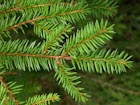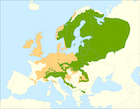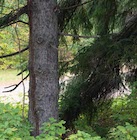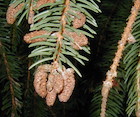Picea abies
(Linnaeus) Karsten 1881
Common names
Norway spruce, epicéa commun (French French) (Farjon 1990), épinette de Norvège (Canadian French) (Taylor 1993), gemeine fichte (German), jel europeiskaya (Russian) (Farjon 1990).
Taxonomic notes
Synonymy:
- Pinus abies Linnaeus 1753;
- Abies tenuiori Miller 1854;
- P. rubra A. Dietr.;
- P. vulgaris Link;
- P. excelsa Link;
- P. montana Schur;
- P. abies var. europaea (Tepl.) Jurkev. et Parv.
Numerous varietal and subspecific names have been published, but few are sufficiently distinct to be worth recognising. The most widely recognised is var. acuminata (Beck) Dallimore & Jackson from the SE of the range in the Balkan Peninsula (Farjon 1990). However, molecular analyses have clearly indicated the presence of two highly distinct races of P. abies, one located in Scandinavia and the Baltic region north of about 52°N, and the other located in alpine and Balkan regions south of there (Tollefsrud et al. 2008). The analysis of molecular markers for all species of Picea by Lockwood et al. (2013) also identified these two groups, and indicated that they are not monophyletic (see this cladogram); in fact, the southern populations may constitute a distinct cryptospecies, although this taxonomic question has not yet been resolved.
A large area of hybrid introgression with P. obovata has developed since the two species met after the last Ice Age between the Ural Mts and Finland, treated as Picea × fennica (Regel) Komarov (Farjon 1990). Some authors treat P. obovata as a subspecies or variety of P. abies.
Prior to the formal description of Abies and Picea, those sorts of trees were all colloquially called "spruce fir" although Linnaeus had assigned them to the genus Pinus (see, e.g., Lambert 1803). This particular species, widely distributed in Europe, had been called Picea since Roman times, but Linnaeus (1753) erroneously assigned the epithet abies. At that point there really weren't any rules of botanical nomenclature, so when in the very next year Miller (1754) created Abies, he gave this species the completely new name Abies tenuiori with the common name "Norway or Spruce Fir," and then when Dietrich (1824) created Picea, he renamed it Picea rubra. It remained for Karsten (1881) to do the nomenclaturally correct thing and unite Dietrich's genus name with Linnaeus's epithet.
Description
Trees to 40–50 m tall and 100–150 cm dbh; crown conic. Bark orange-brown, finely flaking, becoming gray-brown, scaly on old trees. Branches short and stout, the upper level or ascending, the lower drooping; twigs orange-brown, usually glabrous. Buds reddish brown, 5–7 mm, apex acute. Leaves 1–2.5 cm, 4-angled in cross section, rigid, light to dark green, bearing stomata on all surfaces, apex blunt-tipped. Seed cones (10–)12–16 cm; scales diamond-shaped, widest near middle, 18–30 × 15–20 mm, stiff, leathery, margin at apex erose to toothed, apex extending 6-10 mm beyond seed-wing impression. 2 n =24 (Taylor 1993, M.P. Frankis, pers. obs. 1999.01.06).
Var. acuminata is distinguished by longer-than-average cones (to 18 cm, the longest of any spruce) with more acute cone scales (Farjon 1990).
Hybrids with P. obovata (P. × fennica) and P. alpestris show pubescent shoots and cones with more rounded scales (M.P. Frankis, pers. obs. 1999.01.06).
Distribution and Ecology
This is one of those species that has been economically important to humans for so long that it has been dispersed and has naturalized in many areas outside its native range. Schmidt-Vogt (1974) thoroughly investigated evidence of its native range and assigned it to Albania, Austria, Belarus, Bosnia & Herzegovina, Bulgaria, Croatia, Czechia, Estonia, Finland, France, Germany, Greece, Slovenia, Italy, Latvia, Lithuania, Macedonia, Montenegro, Norway, Poland, Romania, Russia, Serbia, Slovakia, Sweden, Switzerland, and Ukraine. The map shown here includes those countries and additionally identifies naturalized populations in Belgium, Ireland, Denmark, Hungary, Luxembourg, Netherlands, Spain, and the United Kingdom. Naturalized populations are also known in Canada and the United States (Taylor 1993). These are primarily in Canada: New Brunswick, Nova Scotia, Ontario, Prince Edward Island, Québec; and USA: Connecticut, Indiana, Kentucky, Maine, Maryland, Massachusetts, Michigan, Minnesota, New Hampshire, New Jersey, New York, North Carolina, Ohio, Pennsylvania, Rhode Island, South Carolina, Tennessee, Utah, Vermont, Virginia, West Virginia, Wisconsin. West of the Ural Mountains, there is a broad zone of hybridisation with Picea obovata.
Hardy to Zone 4 (cold hardiness limit between -34.3°C and -28.9°C) (Bannister and Neuner 2001).
Remarkable Specimens
Largest
Within most of the species' range, 100 cm dbh is quite a large specimen, partly because of the general rarity of old trees; outside of the northern forests, old forest is rare in Europe. The largest specimen is a huge, wolfy tree in Austria, which has a 284 cm dbh (892 cm girth) and is about 35 m tall (Monumental Trees 2019.12.18, which also provides photos). This tree has two huge reiterations that rather exaggerate its size; the largest monopodial specimen is 214 cm dbh (671 cm girth), albeit tapering rapidly above that height (160 cm at 2.2 m), and is 56.2 m tall as of 2012. It grows in the forest of Biogradska Gora National Park, Montenegro (full report and photographs: Räsänen 2008 and Monumental Trees 2019.12.18). Kouta Räsänen (email 2010.12.25) states that "P. abies of 100 cm dbh are common in the old-growth remnants of the mountains of southern and central Europe. Picea abies and Abies alba are usually the largest trees, the former often having larger dbh, but the latter having larger volume due to slower stem taper." There is also record of a tree 153 cm dbh and 45 m tall from the Bagni di Mezzo, Trentino Alto, San Pancrazi, BZ, Italy (Corpo Forestale della Stato, a listing of big trees in Italy, no longer online). The largest cultivated tree of which I have record is 151 cm dbh (as of 2013) at Lingholm, Cumbria, UK (Mitchell et al. 1990 [as 147 cm], Monumental Trees, 2019.12.18).
Tallest
The tallest known tree is the "Sgerm Spruce," 126 cm dbh and 62.7 m tall in 2019, which grows in Sgermova Kmetija, Ribnica na Pohorju, Slovenia (Monumental Trees, 2019.12.18). It is estimated to be 250 years old, based on a ring count of a fallen nearby tree of similar size, and has been measured repeatedly using professional methods (including theodolite, laser, and direct tape drop); it was 51 m in 1938, 57.5 m in 1980, and 61.7 m in 1995 (Räsänen 2012).
The second-tallest specimen is 59.3 m tall. This well-known tree is in Sächsische Schweiz National Park, Germany. The same park contains a number of other trees measured at over 50 m tall (Räsänen 2010 and email, 2019.10.11).
A 58.1 m tall tree in the Dobroč Reserve, last measured in 2015, is the tallest tree known tree in Slovakia (Monumental Trees 2019.12.18).
A 55.4 m tall tree in the Rezerve Parangalitsa is the tallest tree in Bulgaria (Monumental Trees 2022).
A 49.3 m tall tree near Forshaga is the tallest tree in Sweden, but as of 2020 appeared to be likely to succumb to a bark beetle infestation (Ruth 2020.07.30).
Oldest
The oldest known living specimen, 534 years, was documented in a tree-ring chronology covering the period 1466-2011 (fully crossdated), collected in the Kyzgych Valley, Republic of Karachayevo-Cherkessiya, Karachaevskiy district, Russia by Olga Solomina and others (doi.org/10.25921/xm5v-pc62). A second tree in the chronology had a record only 2 years shorter that ended in 1997; it could be that this tree was dead, or there may have been a sampling problem, so it could have been older. See also Solomina et al. (2022). Another very old tree has been recorded in the Bavarian Forest of Germany, which had a crossdated age of 468 years. It was collected by R. Wilson (RMTRR 2006).
In 2008, the popular media widely distributed news of a 9,550-year-old specimen of P. abies found in Sweden. The authors of the study, Leif Kullman and Lisa Öberg, actually asserted that they had found a clone that was as much as 9,550 years old, and this was not so astonishing; a variety of Picea species have been shown to reproduce by layering in habitat, and in fact clones of considerable age have been found at least in Picea engelmannii (Marr [1977]; at the alpine treeline on Niwot Ridge, Colorado) and Picea mariana (Légère and Payette [1981]; at the arctic treeline on the Ungava Peninsula, Quebec), and some tree clones have been found of even greater antiquity, as in the case of the Utah aspen (Populus tremuloides) clone shown to be at least tens of thousands of years old (DeWoody et al. 2008). No one had previously claimed to have found a Picea clone of such antiquity, but if anyone had done so, Kullman was a good candidate; he has a very long publication record on the subject of trees growing at their arctic and alpine limits. Kullman and Öberg's work was published in Kullman (2009) and in Kullman and Öberg (2009), and in several subsequent papers. However, Mackenthun (2016) critically examined Kullman and Öberg's analyses and found (a) no evidence of genetic continuity between dead wood remains discovered beneath the allegedly 9550-year-old tree and the living tree itself, and (b) no evidence of a clonal origin of the tree. The problems of finding clones of great age and inferring their continuity are substantial. When we look at arctic treelines around the world, we find that they sometimes experience primarily clonal reproduction (where the treeline species are capable of it), and sometimes sexual reproduction. The null hypothesis would be that sexual reproduction is episodic over time, occurring during climatic warm intervals that favor complete cone and seed development, with reversions to clonal reproduction during less favorable periods. Therefore, absent evidence to the contrary, the Swedish trees do not represent a 9,000-year-old clone, and the oldest clonal age in this species remains unknown.
Ethnobotany
Picea abies is a timber tree of major economic importance throughout the cool temperate areas of Europe. The commonest tree used for Christmas trees in Britain, despite its poor suitability for this purpose, with the leaves soon shed as it dries out. A herbal tea can be made from the leafy twigs and is reputed to have various curative powers, not tested medicinally.
This is the most widely used horticultural spruce in North America; many cultivars exist, including dwarf shrubs (Taylor 1993). Three times (as of 2017) it has served as the U.S. Capitol Christmas tree.
This is probably one of the most widely used tree species in dendrochronology. A 2016 literature search found studies of changing climate (using ring-width, x-ray, and stable isotope data), forest age structure, decay rates in dead wood, air pollution effects, wide-area forest productivity, ecophysiology, radionuclide sequestration, archeology of old buildings, interspecific competition, the structure of Stradivarius' violins, and many other diverse topics.
Observations
Remarks
Picea abies appears to be the most climatically tolerant species in the genus, prospering in cultivation in both extreme oceanic NW Scotland and central continental Wisconsin. This might be a legacy of adaptation to rapidly fluctuating climates in Europe during the Ice Ages (and now, for that matter).
Conifers in general have enormous genomes; a single chromosome may have as many base pairs as the entire genome of a single human. P. abies is one of the few conifers that has been sequenced, its genome containing 20 billion base pairs (Nystedt et al. 2013).
Citations
Caudullo, G., E. Welk, and J. San-Miguel-Ayanz. 2017. Chorological maps for the main European woody species. Data in Brief 12, 662-666. DOI: https://doi.org/10.1016/j.dib.2017.05.007
DeWoody, J., C. A. Rowe, V. D. Hipkins, and K. E. Mock. 2008. Pando lives – molecular genetic evidence of a giant aspen clone in central Utah. Western North American Naturalist 68: 493–497. doi: 10.3398/1527-0904-68.4.493.
Farjon, Aljos. 1990. Pinaceae: drawings and descriptions of the genera Abies, Cedrus, Pseudolarix, Keteleeria, Nothotsuga, Tsuga, Cathaya, Pseudotsuga, Larix and Picea. Königstein: Koeltz Scientific Books.
Frankis, M. P. 1992. Picea. Pp. 570-573 in A. Huxley, M. Griffiths and M. Levy (eds.), The New RHS Dictionary of Gardening, volume 3. Grove's Dictionaries.
Holeksa, J., M. Saniga, J. Szwagrzyk, M. Czerniak, K. Staszyńska and P. Kapusta. 2009. A giant tree stand in the West Carpathians—An exception or a relic of formerly widespread mountain European forests? Forest Ecology and Management 257: 1577–1585.
Karsten, Hermann. 1881. Deutsche Flora. Pharmaceutisch-medicinische Botanik. Ein Grundriss der systematischen Botanik zum Selbststudium für Aerzte, Apotheker und Botaniker. P. 324. Available, Biodiversity Heritage Library, accessed 2020.11.26 (has a nice illustration).
Kullman, L. 2009. Fjällens evighetsgranar – Svensk naturhistoria i nytt ljus. [Eternal spruces of the fjäll – Swedish natural history in new light]. Svensk Botanisk Tidskrift 103: 141–148.
Kullman, L. and L. Öberg. 2009. Post-little ice age tree line rise and climate warming in the Swedish Scandes. A landscape ecological perspective. Journal of Ecology 97:415–429. doi: 10.1111/j.1365-2745.2009.01488.x
Légère, A., and S. Payette. 1981. Ecology of a black spruce (Picea mariana) clonal population in the hemiarctic zone, northern Quebec: population dynamics and spatial development. Arctic and Alpine Research 13(3):261–276.
Leibundgut, H. 1982. Europäische Urwälder der Bergstufe. Verlag Paul Haupt, Bern, Stuttgart.
Mackenthun, G. 2016. The world's oldest living tree discovered in Sweden? A critical review. New Journal of Botany 5(3), DOI 10.1080/20423489.2015.1123967.
Marr, J. W. 1977. The development and movement of tree islands near the upper limit of tree growth in the southern Rocky Mountains. Ecology 58:1159–1164.
Monumental Trees. 2015. Norway spruce in Dobrocský prales, Cierny Balog, Banská Bystrica, Slovakia
. monumentaltrees.com/en/svk/banskabystrica/brezno/11559_dobrocskprales/22660/, accessed 2019.10.24.
Nystedt, B., N. R. Street, A. Wetterbom, A. Zuccolo, Y.-C. Lin, D. G. Scofield, F. Vezzi, et al. 2013. The Norway spruce genome sequence and conifer genome evolution. Nature. 497(7451):579–584.
Räsänen, K. 2008.12.21. Big Norway Spruces. www.nativetreesociety.org/worldtrees/europe/20081221-norwayspruce/big_norway_spruces.htm, accessed 2010.12.27
Räsänen, K. 2010.08.23. Tall trees in Sächsische Schweiz National Park, Germany. www.ents-bbs.org/viewtopic.php?f=198&t=1254, accessed 2010.12.27.
Räsänen, K. 2012.10.27. The Sgerm Spruce – the tallest native European tree? www.ents-bbs.org/viewtopic.php?f=386&p=19788#p19788, accessed 2012.11.04.
Schmidt-Vogt, H. 1974. Das natürliche Verbreitungsgebiet der Fichte (Picea abies [L.] Karst.) in Eurasien. Allgemeine Forstund Jagdzeitung 145:185–197.
Solomina, Olga, Vladimir Matskovsky, Ekaterina Dolgova, Veronika Kuznetsova, Nadezhda Semenyak, Tatiana Bebchuk, Vladimir Mikhalenko, Alexey Karpukhin and Bulat Khasanov. 2022. Tree-ring data set for dendroclimatic reconstructions and dendrochronological dating in European Russia. Scientific Data 9:367. doi: 10.1038/s41597-022-01456-6.
Stöber, Kurt. 1999. Images from Thomé, Flora von Deutschland etc. http://www.mpiz-koeln.mpg.de/~stueber/thome/index.html, accessed 2003.05.01, now defunct.
See also
Elwes and Henry 1906-1913 at the Biodiversity Heritage Library (as P. excelsa). This series of volumes, privately printed, provides some of the most engaging descriptions of conifers ever published. Although they only treat species cultivated in the U.K. and Ireland, and the taxonomy is a bit dated, still these accounts are thorough, treating such topics as species description, range, varieties, exceptionally old or tall specimens, remarkable trees, and cultivation. Despite being over a century old, they are generally accurate, and are illustrated with some remarkable photographs and lithographs.
The FEIS database.






